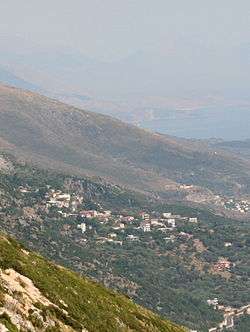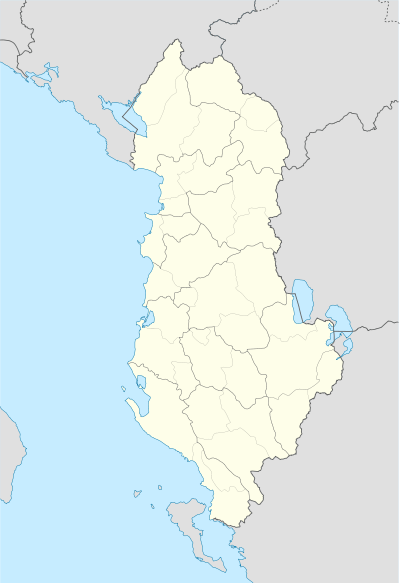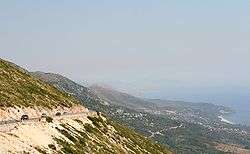Palasë
| Palasë | |
|---|---|
| Village | |
 | |
 Palasë | |
| Coordinates: 40°9′54″N 19°37′29″E / 40.16500°N 19.62472°ECoordinates: 40°9′54″N 19°37′29″E / 40.16500°N 19.62472°E | |
| Country |
|
| County | Vlorë |
| Municipality | Himarë |
| Administrative Unit | Himarë |
| Population | |
| • Total | 413 |
| Time zone | CET (UTC+1) |
| • Summer (DST) | CEST (UTC+2) |
Palasë (also Paljasa,[1] from Greek: Παλάσα, Palasa) is a village close to the Llogara National Park in the Albanian Riviera. It is located in the municipality of Himarë (13 kilometres from the town), in the Vlorë County, Albania.[2] The inhabitants of Palasë speak mainly a variant of the Himariote Greek dialect, and partly the Tosk Albanian dialect.[3]
History
In classical antiquity there was a settlement of the Chaones, one of the three major ancient Greek tribes of Epirus, named Palaesti (Greek: Παλαίστη).[4] On January 4, 48 BCE during his pursuit of Pompey, Julius Caesar landed in Palaeste (modern Palase).
In 1720, the villages of Himara, Palasa, Ilias, Vuno, Pilur and Qeparo refused to submit to the Pasha of Delvina.[5]
Until the 1750s Himarë was composed of more than 50 villages,[6] but by the end of the 1780s it comprised only 16, situated by the seashore from Saranda to Palasë.[7] Later on, with Ali Pasha's defeat, the region of Himara shrunk to only seven villages. In September 1916, the provinces of Himarë and Tepelenë became part of the Vlorë prefecture and were placed under the control of the Italian armed forces. The city of Himarë became the official capital of the region and was responsible for the administration of the traditionally Orthodox coastal villages of Palasë, Dhërmi, Kudhës, Qeparo, Vuno and Iljas.[8] However each village retained its own identity, despite falling under the municipality of Himarë.
Geography
The village is located several kilometres northwest of the town of Dhërmi, accessed via the main road leading out of the town. The Llogora Pass and Çika Mountain are nearby. The Thunderbolt Mountains, the western chain of the Ceraunian Mountains, enclose the area on its northern and northeastern side. The area opens up on its southwestern side with the mountain of Çika and descends towards the Ionian coast and the Greek Islands of Othonas and Corfu in the distance.

The village contains narrow stone roads and quaint white houses and is built around a 400-year-old platanus (plane tree), which is central to village life and the pride of the village. Geologically the terrain belongs to the western part of the Ionian Tectonic plate.[9] This section of the coastline is referred to by geologists as the Palasë-Butrint coastline. The Palasë beach is 1.5 kilometres in length.[10]
North of Palasë, is located a small bay, named Grammata ('letters' in Greek), accessible only by sea, with the surrounding cliffs containing various epigraphs, texts and symbols, perhaps carved out by sailors.[11]
Language
The inhabitants of Palasë are bilingual as they mainly speak a variant of the Himariote Greek dialect, and partly the Tosk Albanian dialect.[3]
Notable people
- Aleks Caci, writer and publicist
- Paskal Milo (born 1949), politician
- Ilir Paco (born 1974), editor in chief of news departament at the biggest Albanian TV channel, Top Channel
See also
- Ceraunian Mountains
- Chaonians
- Dhermi
- Greeks in Albania
- Himara
- Himariote Greek dialect
- Tourism in Albania
References
- ↑ A Gazetteer of Albania (1946), Permanent Committee on Geographical Names for British Official Use, House of the Royal Geographical Society
- ↑ Law nr. 115/2014
- 1 2 Gregorič, Nataša. "Storytelling as a spatial practice in Dhërmi/Drimades of southern Albania" (PDF). Anthropological Notebooks. 2 (14): 5. 1408-032X. Retrieved 2009-11-28.
They primarily use the Greek dialect and partly the southern Albanian (Tosk) one in their day to day conversations.
- ↑ Sakellariou M.V. (1997). Epirus, 4000 years of Greek history and civilization. Ekdotikē Athēnōn. p. 20. ISBN 978-960-213-371-2.
- ↑ Etnografia shqiptare. 15. Akademia e Shkencave e RPSH, Instituti i Historisë, Sektori i Etnografisë. 1987. p. 199.
- ↑ Bulletin of Social Sciences (Albanian: Buletin për Shkencat Shoqërore, II, Tiranë, 1955, p. 159: part of the Letter sent from the people of Himara to the Tzarine Elizabeta Petrovna
- ↑ Studime historike (1964). "Dokumente: Kapiteni Dedoviç, Vjenë, më 30 korrik 1787. (English: Documents: Captain Dedowitch, Vienna, July 30th, 1787)". Studime historike (English: Historical Studies) (in Albanian) (4).
- ↑ Murzaku, Ines Angeli (2009). Returning Home to Rome - The Basilian Monks of Grottaferrata in Albania, Volume 7. Analekta Kryptoferri. p. 112. ISBN 88-89345-04-7.
- ↑ Marinos, Paul G. (June 1997). Volume 2 of Engineering Geology and the Environment, International Association of Engineering Geology. Taylor & Francis, organized by the Greek National Group of IAEG, Athens, Greece. p. 1311. ISBN 90-5410-879-7.
- ↑ "Destination Guide". Tourism in Albania. Retrieved August 26, 2010.
- ↑ Tourist Guide of Himara. Bashkia e Himares, p. 33.
